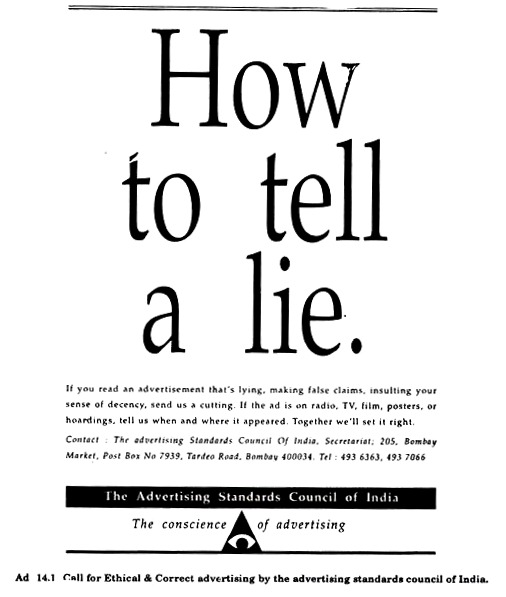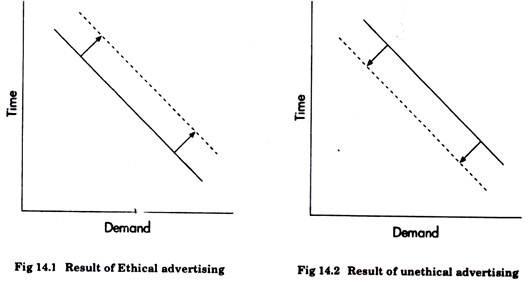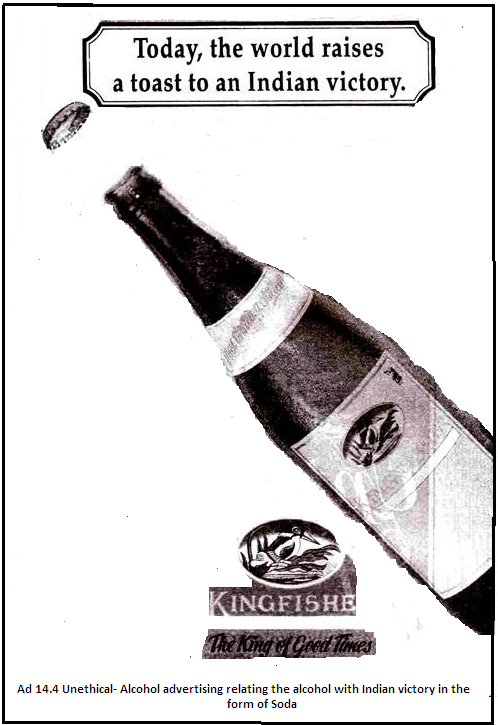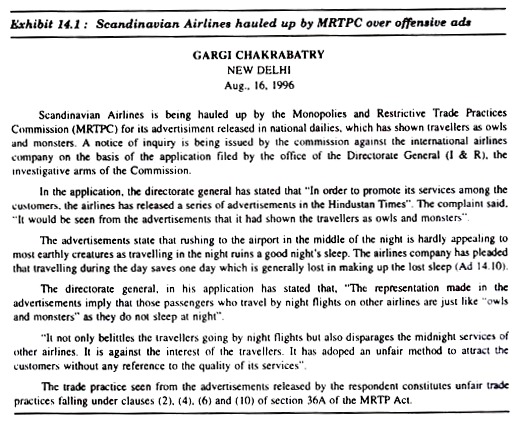This article provides an essay on social aspects of advertising.
Introduction to Social Aspects of Advertising:
It is argued that the biggest and potentially most insurmountable problem encountered in any attempt to examine and evaluate the social issues surrounding advertising stems from the essentially subjective nature of many of the criticisms that have been levelled in recent years.
Although social and ethical criticisms of advertising are by no means new, the nature & seriousness of the complaints made has in recent years increased significantly.
An additional problem is encountered in the form of the sheer volume of the criticisms that have been made. This trend has in turn been supported and reinforced by the attention paid by successive governments to the role of advertising and the rise of consumerism.
Criticisms:
Followings are the eight criticisms which in so far as are made most frequently and because they bear the direct relationship to the ethics of advertising are most pertinent to such discussion.
These criticisms are:
1. Advertising is frequently false and misleading.
2. Advertising concentrates on selling products to people they neither need nor want.
3. Advertising exhibits bad taste.
4. Advertising stresses small and insignificant differences between products and has resulted in an unnecessary and wasteful proliferation of brands.
5. Advertising is too persuasive.
6. Advertising can be used to take advantage of children (bad effect on children).
7. Much advertising is irrelevant and unnecessary.
8. Advertising has resulted in uniformity.
When we evaluate social problems in relation to advertising, we are in the area of personal value judgement. How can deficiencies in our social system be corrected? How can things be managed so that people will get more of the essential necessities without giving up too much of their basic freedom of choice and action?
What part does advertising play in helping to accentuate or relieve those conditions? We find that there is a tendency for the critics of advertising to base their allegations of its social value on debatable grounds and assumptions.
Charges Labelled Against the Advertising:
The charges labelled against the advertising can be explained in the following ways:
1. A manufacturer of cosmetics uses the appeal that the company’s cosmetic will make a young women more lovable and will attract young men to her. In her fantasy life, the young woman will probably want to be lovable and to attract a young man.
And certainly she will be more attractive in real life if she is well groomed than if she is not. We learn from advertising that a particular brand of carpet will make a living room more attractive or that this new lighting fixture will make a hall brighter. These, and many other similar statements, are true. They do not, however, say that they will accomplish the impossible.
2. People want to look better, eat better, live in better houses, drive better cars—in fact improve all aspects of their living. Merchandise that may entirely or partially satisfy the wants of the consumer may be sold more easily through persuading the prospect with the right appeal.
3. The charge is that advertising forces consumers to want merchandise that they can not afford. But as we know that the advertising cannot move people in directions contrary to social trends and their preferences.
One of the reasons why companies use marketing research is to find out how to advertise products and services to coincide with the demand of consumers. Advertising cannot bring about any thing that would not occur without advertising, but it does not hasten product adoption and use.
The number of times that advertising has not been able to get consumers to buy products with a declining trend or that advertising could not get consumers to adopt a product in advance of the time it seemed propitious, is great enough to dispel the belief that advertising has the ability to do more than advance effective suggestions.
4. The charge is that advertising lacks good taste? If the advertiser does not advertise the products & services that the Indian public openly buys, what other standards would be used to select the products. No doubt, some radio and television commercials are obtrusive and irritating. If the public is offended by the appeals used, the advertiser may soon find out their disapproval through a decrease in sales.
The first obligation of advertising is to communicate with the Indian public. Magazines newspapers, television programmes and radio programmes are moulded to the public taste. Some people are more aesthetically oriented and more sensitive than the general run of advertising readers, listeners or viewers.
If so, they may find some consumer advertising distasteful. That fact does not mean that the advertising now done is not gauged carefully to the level of most Indians. If it were not, it would indeed be wasteful.
1. Another charge is that advertising give undue stress on material things. It is obvious and it does stress. Does this mean that there has been a decline in the stress placed on people’s cultural and spiritual needs? Have people’s interest in intellectual and aesthetic pursuits declined because of advertising? Or are they less than they would be if we had no advertising.
2. Charge is that advertising lure people buy goods they do not need. It is certainly true that much of the advertising of today is designed to sell new products that are not necessities at present.
However, many of the products called non-necessities today become what people consider necessities for a reasonable standard of living tomorrow, as was the case with the vacuum cleaner and the ceasefire. Much of the criticism that advertising sells people things they do not need is directed more at the fact that people buy things the critics does not think they should want.
The question naturally arises as to who is to make the decision of what people should want. Many believe it is consumer who should decide what he wants and needs, and not the critics or a government agency or another authoritarian body. If consumer’s freedom of choice in the market place is taken away, they might lose many other freedoms also.
To some people it would appear strange that legislators, economists, political scientists, and historians who are so often the ones who believe that the consumer should not be allowed freedom of choice, and the advertiser freedom of advertising, are the loudest in their demands for the freedom of speech to say what they think and the freedom to protest the causes of which they do not happen to approve.
Since advertising (so long as it does not violate standards of good taste, ethics; and so forth) is one form of free speech, it would appear reasonable that it be permitted and that consumers have the privilege of deciding what products they need and want, whether or not they happen to be what critics call necessities or luxuries.
Consumerism:
It has become a issue confronting not only private managers but public policy makers as well. It has taken a form’ of consumer movement, a loose & changing grouping of people and voluntary organisations.
The concern is often based on the assumptions that consumers are unorganized, ill informed, even without purpose or direction and perhaps unable to decide what is good for them.
Although consumers occupy the central position in the economic system, they have not always received the attention to which they are entitled.
1. The number of brands of the various items complicates the consumer’s selection to even greater degree.
2. The information about the products and services that is offered may be misleading and confusing.
3. If is difficult for the consumer to judge the quality of the products and services (e.g., insurance) in the market.
4. There is a tendency for some sellers to try to get the consumer to purchase on the basis of emotion rather than on the use of objective data.
5. Due to insufficient knowledge of Consumer Behaviour, an accurate blue print for defining products and services in terms of consumer choice is not available.
6. It is too complex for the average consumer to evaluate the myriad conflicting claims of competing manufacturers.
7. The consumer ends up by paying for a major share of the wastes involved in marketing.
8. The consumer may lack the education and knowledge to judge what is the best buy relative to his preferences.
It would be naive to assume that all business people are altruistic and virtuous. Much of the legislation that protects the consumer from adulterated and harmful products has been important to our public interest. There are those however, who believe that consumers not only need protection from the ills they cannot determine or foresee, but also that they need guidance in getting their money’s worth.
Future:
Consumerism is here to stay, tomorrow’s consumers will be better educated, more affluent and more critical. They will probably be less concerned with status symbols and more anxious to get information about to products.
They will expect management to accept greater social responsibilities even if this results in a decrease in short run profits. For management who fail to measure up to the standards, there will be increased government regulations, consumer dis-contention and consumer boycotts.
Freedom of consumer choice is more important socially and economically than is conformity to one set of criteria. What is waste for one consumer may be wisdom for another. We live in a competitive economy. Business can prosper if it offers consumers what they want.
So long as consumer protection is confined to shielding consumers from dangers that they cannot foresee or avoid, the enforcement of contracts, and the curtailment of fraud and deception. There is greater merit in allowing competition to enforce the meeting of consumers’ taste with respect to variety, quantity and quality of products and services.
Through mass production and mass distribution methods, the average Indian consumer has been able to secure a great variety of products. Nevertheless, because of these techniques it is inevitable that the inherent danger involved in large scale production and distribution process may result in defective products and misleading marketing strategies.
Therefore, recommend that:
1. Pricing strategy be set on a unit basis to allow the consumer to make more realistic comparisons.
2. Better procedures be instituted whereby consumer’s, seller’s, manufacturer’s complaints can be handled.
3. More effective quality control procedures be established by manufacturers.
4. Manufacturers should take the initiative in setting standards for safety, service, and certification.
5. Warranties for products be simplified and the distribution link closest to the consumer be given greater autonomy in rendering the service on these warranties.
6. Improved Communication methods be developed at all marketing levels.
7. Business should make a greater effort to prognosticate the social problems of the consumer.
8. Business organisations should support policies and programs aimed at giving consumers more information and protection.
9. Marketing and advertising strategies be re-evaluated in order to mirror more effectively the evolving social and ethical norms of the younger generation.
10. Finally, the credibility of business in the eyes of the consumers be reinforced
The Development Perspective:
1. Advertising reinforces a ‘consumerist culture’ which is marketed by the urge to spend and to acquire.
2. It is not about the products and services alone that people learn from advertising (especially consumer product advertising). Advertising also tends to promote attitudes and life styles.
3. According to Herbert Marcuse, “advertising provides a culture of exaggerated self-awareness, self-righteousness and monetary pleasures of self-assertions a kind of mass narcissism—which destroys the bonds of basic human loyalties in the family friend groups and in the community”.
4. The language and imagery of advertising is marked by hyperbole, superlatives and stereotypes of men, women and different ethnic groups. The man is usually macho, the women glamorous the children cute and innocent. Such images glorify charm seduction, spending and giving.
5. Advertisers are responsible for bringing a new kind of ‘globalism’ to marketing. Globalism promote the universal commercial values of exploitation and profiteering at the expense of developing world. Such advertising can also distort the development priorities of poor countries.
6. Advertising doesn’t reflect the changing cultural values of a society. At times, it itself acts as a change agent while doing so it should not loose sight of the developmental perspective.
Ethics in Advertising:
Ethics represent a set of moral principles and values. Ethics are concerned with good or bad. Morality is concerned with the right type of conduct. It represent a set of principles of right and wrong behaviour. Ethical advertising contains truth.
It should be right in its approach and claims. It is immoral for an advertiser to deceive his prospects. Ethical advertising can shift the demand curve to the right (Fig 14.1), unethical advertising can shift the demand curve of firm to the left (Ad 14.2).
Advertising is considered unethical when:
1. It gives false information.
2. It degrades the rival’s product or substitute product.
3. It makes exaggerated or tails claims.
4. It is against the national and public interest.
5. It gives misguiding information.
6. It conceal information that vitally affects human life, e.g., stole effects, precautions.
7. It is obscene or immoral.
Unethical advertising can take any of the following forms:
1. The use of sex, especially the use of women as the sex objects:
It is true in case of many products like after shave,–mobiles in which the women is used in advertisements but in real life, women has nothing to do with these products. By using women as a sex objects the advertisers try to arouse the stereotype sex roles (Ad 14.2, 14.3).
2. Alcohol & Tobacco Advertising:
Though the alcohol advertising is banned on broadcast and print media in India but then also it appears indirectly through the advertisement of soda. (Ad. 14.4).
Though the tobacco advertising is not banned on print media, then also the advertiser should avoid themselves to use advertisement because use of tobacco is injurious to health and not good for youth of the country. Rather the advertisers give very catchy advertisements of cigarettes and give the psychological impression that smoking cigarettes is graceful.
3. Untruthful Claims:
For example, the advertisement of Feeder Loyd’s air conditioners claim that the air conditioner is fitted with U.S. made compressor but actually it was fitted with Kirloskar’s compressor.
Advertisements offering mixtures and substances which promise loss of weight, growth of hair, sexual revitalization are categorized as unethical.
1. The use of testimonials or endorsements:
Sport stars and film stars advertise for those products which have nothing to do with their profession and personality. For example, Sunil Gavasker in Dinesh, Kapil Dev in Kawasaki 100, Nabab Pataudi in Gwalior Suiting’s etc.
2. Exaggerated Claims:
It includes doing promises exaggeratedly. For example refer advertisement 14.8, which says clinic all clear will clear all dandruff in just two weeks which look, to be exaggerated claim.
3. Unverified claims in a language that is ambiguous:
Example is maltova advertisement which says that it is a hi-energy drink which is especially good for children. But the question arises what do we mean by hi-energy drink and what are its parameters. And also there is no verification of the energy it possesses. So it is included under unverified claims (Ad 14.9).
Advertising & Children:
Undoubtedly one of the more serious and the most emotive of the criticisms made of advertising concerns the effect that it may have on children. It is felt by many people that children are a great deal more susceptible to the appeals of advertisers than are adults and that, as a consequence, advertisements directed at them should be regulated especially strictly.
Whether regulation over and above the level that is used for adults is in fact really necessary is, however, in dispute. To date, remarkably little research has been conducted to determine the effect of advertisements upon either the purchasing or living behaviour of children, the two notable exceptions being the work conducted separately by Scott ward in America and James Friders in Canada.
The major conclusions reached by ward are as follows:
1. By the age of eleven, children have developed fairly strong attitudes, either positively or Negatively, towards advertisements.
2. Between the ages of seven and eight there is an important break point in a child’s reactions to commercials. He begins to distinguish between television advertisements and the programme, and starts to understand the real purpose of the commercial.
3. Children are quite capable of forming positive and negative attitudes towards advertisements (e.g., adolescents are frequently quite cynical toward advertising).
4. Adolescents frequently acquire consumer attitudes and skills from television advertising.
5. The attention paid to television commercials is no greater than that paid to the programmes in which they appear.
6. Intelligence is better predictor of the child’s ability to recall advertising themes and slogans than is the degree or length of exposure to television advertising.
7. Television advertising is neither the only nor the most important determinant of a child’s expressed wants and purchasing behavior.
Advertising & Cultural Values:
1. We in India expect advertising to promote socially oriented objectives, such as discontinuance of smoking, family planning, physical fitness, the elimination of drug abuse, prohibition of alcohol etc.
2. Culture is the most fundamental determinant of a person’s wants and behaviour.
3. Four types of sub cultures are nationality groups, religions groups, social groups and geographic groups.
4. We demand that advertising should respond to our cultural values.
5. Each culture contains smaller groups of sub cultures that provide more specific identification and socialisation for its members.
6. Of course some cultural values become out dated and must be changed. External or core cultural values are very difficult to change by advertising. For example getting married is a core cultural value, but getting married early is a sub culture value. It may be changed by forces like advertising.
The advertising industry should, attempt to regulate itself to ensure the abuses of the bad tastes.
7. Now the advertisers are tending towards social issue.
Advertising & Standard of Living:
The standard of living is an index of the products used by the people in their day to day life, it refers to the consumption pattern of the people, reflecting the conditions of living in a country.
Has advertising contributed to the ability of the masses to acquire and enjoy increased quantities and varieties of commodities? Most people would grant that advertising, through its contribution to more effective marketing and selling in the India economy, has made considerable contribution to the present high standard, of living.
It has been a contributing factor, along with many others, in developing in people and motivation to work harder in order to acquire the many luxuries made available by our productive economic system. The knowledge of such new products and improved products and the potential enjoyment to be realized by their possession have been brought to the attention of many individuals through advertising.
Undoubtedly advertising has played a part in creating this desire among Indians to labour and to produce, and in turn to be able to acquire and possess and enjoy these goods and services that will lift their lives above the subsistence level.
1. Over a period of time the standard of living may improve through economic prosperity.
2. Prosperity generates a better standard of living, advertising stimulates the desire for better things in life.
3. Advertising makes people aware of their needs which make them aspire to a high standard of living.
Todays economy is geared to a high level of consumption. If high levels of production and employment are to be maintained, and the economy is to continue to grow, consumers will have to continue to maintain, if not increase, their standard of living with reference to material goods. Certainly advertising play a considerable role in stimulating this continued high standard of living among Indians.
This is especially true in light of the fact that large portion of today’s production is of goods not required to meet human physiological needs, but is designed to meet psychological wants.
Potential consumers of such new goods, which might be considered luxury or semi-luxury by many, must be educated to desire such products if the economy is to function smoothly. One of the key influences in such education is advertising.
1. Advertising can create a mental revolution which will inspire in the population a thirst for better living.
2. Raising the standard of living is dependent on a number of factors as :
(a) The living conditions of the majority of people in a community.
(b) The income level and purchasing power of families.
(c) The cultural values of the community.
(d) Cost of living which depends upon the development of national, regional and local economy, the production levels of basic goods and on sharing the social wealth.
3. The power of advertising to raise standard of living becomes limited if the social, economic, cultural and political factors are unfavourable.
Code for Commercial Advertising on Doordarshan:
The code for commercial advertising was presented to parliament in 1987. It contains 33 does and don’ts for advertisers. It incorporates the indecent representation of women act and the consumer act, both of which passed by parliament in 1986.
According to this code, the following advertisements should not be permitted:
1. Ads which exploit national emblem, any part of the constitution/personality of national leaders or state dignitaries.
2. Ads which have any relation to religion, political or industrial dispute.
3. Ads which decried any race, cast, colour, creed, and nationality or are against the directive principle or the constitution.
4. Ads which tend to incite people to crime or cause order or adversely affect friendly relations with foreign states.
5. No advertisement shall be presented as news.
6. Ads which promote chit funds, money lenders, jewellery, fortune letters, foreign goods would not be accepted.
7. No derogatory remarks for other products or comparison with them should be made.
8. Ads which are likely to startle viewers-such as gunfire, sirens, bombardments, screams and racuous laughter.
9. Guaranteed goods will have to made available to Director General of Doordarshan for inspection if necessary.
10. Advertisement which portray women as passive or submissive.
MRTP Commission:
MRTPC is a statutory body set up in 1969, to protect the interest of consumers by keeping competition alive and preventing restrictive trade practices.
Restrictive trade practices are any trade practice which tend to prevent, distort or restrict competition in any manner, which results in manipulation of prices or conditions of delivery or which affects the free flow of supplies in the market and thereby imposes unjustified costs or restrictions on consumers.
In 1984, unfair trade practices brought within the purview of the MRTP Act. Provisions were made for monetary compensation for loss or injury sustained by consumers as a result of unfair practices.
Exhibit 14.1 (Ad 14.10) presents the example of MRTPC notice for the Scandinavian Airlines advertisement.








